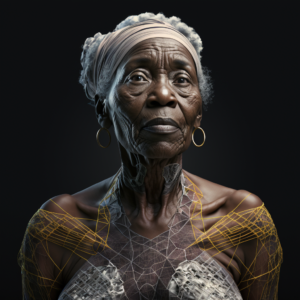
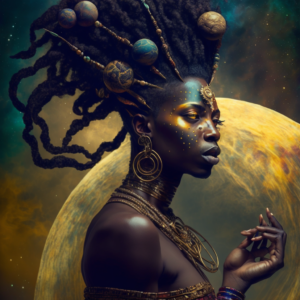
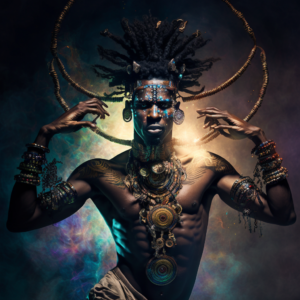
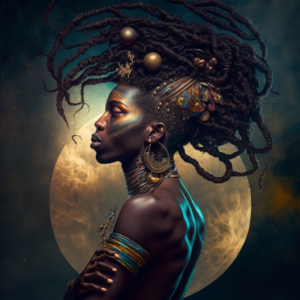
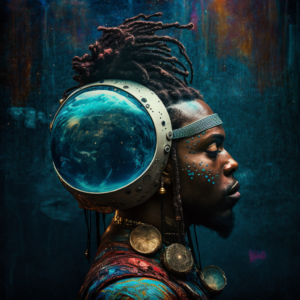
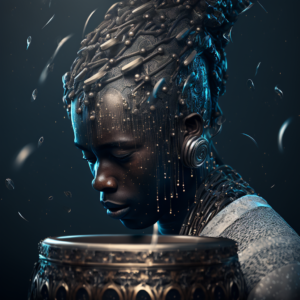
The Anansi Web is a Ph.D project led by Thomas Talawa Prestø, a research fellow at Østfold Community College and the artistic director of Tabanka Dance Ensemble and the founder of the Talawa Technique. Anansis Web is a research project that focuses on the use of ancestral African diaspora dance as a tool for decolonization and resistance. Anansis Web orbits Africana (African and African DiasporaI) coordinates for the how, why, who and where we Dance. Voudou and other Africana polysyncretic theocorporhythmicpractices provide conceptual and theoretical structure and logic. These logics, philosophies and structures are then applied to the production of artistic expression, knowledge and analysis. The project focuses on Africana dance practices and aims to support and empower Africana dance practitioners and decolonial dance practice communities in their search for a methodologies informed by and rooted in Africana cosmologies and philosophies.
Also as the founder of the Talawa Technique, Prestø has developed a fusion of ancestral movements, culturally contextualized vocabulary, and contemporary movement sensibilities that allows dancers to develop full ownership of their bodies’ natural bends and curves, connect to history and culture in an empowering way, and embrace their own identities as well as the multiple identities of Africanist movement.
COLLABORATING COMMUNITIES AND PEOPLE
Expanded Africana Community of Practice with Special mentions:
- Wolman Michelle Luciano
- Joel Ramirez
- Lacky Mahamed
- Pearl Tawiah
- Sarjo Sankareh
- Sidiki Camara
- Shaness Kemp
- L’Antoinette Stines
- Pawlet Brookes MBE
- Tia-Monique Uzor
- Barth Niava
- Yvonne Daniel
- Makeda Thomas
- Tracee Meyn
- Solo Diarra
- Sylvanus Kuwor
- Brenda Dixon Gotschild
- Thomas DeFrantz
- Collette Eloi
- Latanya Stigner
- Quentin Sledge
- Jamie Thompson
- Vicki Igbokwe-Ozoagu
- Alesandra Seutin
- Alexander Montgomery Anderson
- Jamie Philberg
- Melissa Young
- Kariamu Welsh (R.I.P)
- Vivienne Gauthiere (R.I.P)
- Jackie Guy (R.I.P)
ANANSI AND THE WEB
Anansi is a trickster god in African and Caribbean mythology, particularly among the Ashanti people of Ghana and the Caribbean. They are known for their clever and cunning ways, and often uses their wit to outsmart other gods and humans. They are also associated with storytelling and is often portrayed as a spider. In some stories, they are considered to be the creator of the world and the bringer of wisdom and knowledge to humanity.
The image of the web in the Anansi’s Web project serves as a symbol of the interconnectedness and complexity of Africana dance practices, encapsulating the dynamic nature of these practices, and the process of capturing and disseminating knowledge through the projects artistic research work. The web serves as an unifying element, bridging the various forms of research methods, knowledge hierarchies, artistic disciplines, and communities engaged by the project, while providing a unique perspective on the relationship between the body, rhythm, and dance. The web metaphor also guides the exploration of multiple criticalities and intersectional perspectives in the project.
“Pulling threads” refers to the process of examining and understanding individual elements that make up the web of Africana dance practices in the Anansi’s Web project. This micro-perspective allows for a detailed examination of specific dance styles, cultural traditions, and historical contexts that contribute to the complexity of the web.
“Sensing the net” refers to the process of understanding the interconnectedness and dynamic nature of the web of Africana dance practices from a macro perspective. This includes analyzing the impact of movements and changes on the entire web and understanding the interdependence of different elements of the web. It also involves interpreting the movement, rhythm, and energy of the web and how it is disseminated through the artistic research work of the project. This macro perspective allows for understanding the effects of each thread and those which seem not to connect directly.
PART OF THE WEB: COMMITOGRAPHY
Commitography is a term developed by Thomas Talawa Prestø as part of his research project, ANANSI’S WEB, which combines “commit”, “geography” and “choreography” to suggest an engagement with and mapping of the structural and systemic elements of the artistic field. This includes its actions, politics, and self-identity. Commitography is a practice that aims to understand and shape the conditions of artistic creation and the artistic landscape. By involving oneself in boards and committees, individuals engage in a process of strategic analysis and intervention, where they can reveal, understand, and shape the conditions that shape the artistic landscape.
Commitography combines choreographic thinking at its core, understanding that choreography must impose order on the performance, within the three dimensions of space, the fourth dimension of time and the capabilities of the human body. It also apply this thinking to understand and create a form of order or structure to how we understand diversity, inclusion, plurality, and ourselves as an arts field which must be able to cater to and include the previously marginalized (and currently marginalized). This artistic strategic practice, combines the investigative and analytical approach of “geography” with the active, proactive and creative approach of “choreography” to create a powerful tool for artists and art practitioners to understand and influence the conditions of artistic creation, and also to shape a more inclusive and diverse artistic field.
THE DECOLONISED BODY AND SMADDI (PERSONHOOD) IN ANANSIS WEB
The Anansis Web project translates textual research into visual, spoken, and gestural language, as well as sensory experiences, and uses autoethnographic approaches, questionnaires, qualitative interviews, workshops, and performances as methodologies.
The project also employs theocorporhythmic practices, which are theoretical practices that focus on the relationship between the body and rhythm in dance. These practices provide a conceptual and theoretical structure for understanding Africana dance practices and allow for a shift in focus from the individual dancer to the urgency or necessity that is dancing the person. It also explores how polyrhythm and polycentric dance movement, as both philosophical principles and aesthetic elements, can allow for and be the reason for the multiple layering and “density” of African diaspora aesthetics, and how these principles can act as guides and organizing factors for compacting multiple criticalities and intersectional perspectives.
The concept of the “divine horseman” is also taken from Voudun and incorporated in Choreonommo and the Ph.D project. This concept borrowed from Voudun, suggests that the body can be polyspirited, embodying multiple spirits, emotions, anthropomorphic entities, and even the urgencies and needs of the community. The body is conceptualised as a polyspirited and polyconducted (more than one driver) entity ,capable of embodying community, ancestors, spirits, elements of nature, cosmological forces and deities. From this philosophical perspective, it becomes possible to re-examine how social context, politics, and other factors can not only be embodied by the Africana dancing body, but also be the driving force behind the performance and movement. The Choreowanga structure, or ritual of choreography, facilitates the manifestation of this Performancepwen, or power and energy, through the dancer’s movements and the performance as a whole. This understanding of possession and embodiment allows for a deeper exploration of the ways in which dance can be used as a medium for communication, resistance, and transformation.
In the project the body is conceptualised as a polyspirited and polyconducted (more than one driver) entity ,capable of embodying community, ancestors, spirits, elements of nature, cosmological forces and deities. Rhythm is viewed as a mobile institution, language, archive, and technology. The Africana body is perceived to be both host, carekeeper and deciphering key for rhythmic language and communication
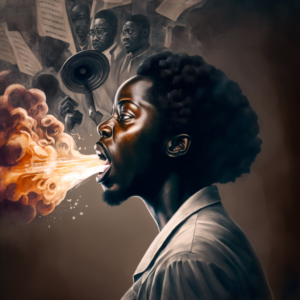
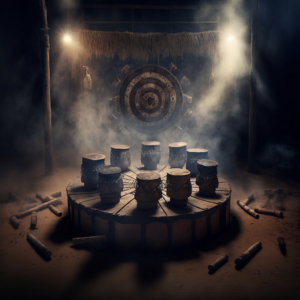
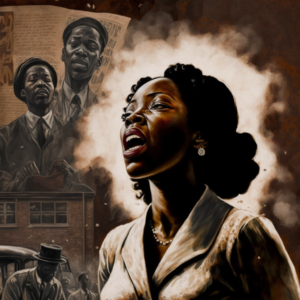
CHOREONOMMO
In this research project, Prestø has developed the concept of Choreonommo, a genre of choreography and performance creation that incorporates the Dogon concept of Nommo. In Choreonommo, Nommo is applied to the choreography and movement as a means of communication and expression, imbued with meaning and significance. The movements and gestures of the dancer are seen as a way of bringing the word to life and making it physically manifest, in line with the idea of embodiment. Prestø learnt about Nommo from Baba Buntu the founder of Norways first afrocentric youth organisation Afrikan Youth in Norway and as such his development as a young artist was founded on this concept.
In Dogon tradition, Nommo is a central figure in creation mythology, believed to be the first living creature created by the sky god Amma and the origin of the first Hogon (spiritual leader and channeler of ancestral knowledge). The Dogon also see Nommo as a powerful deity, capable of giving life to humans through sacrificing their bodies, which is said to be a reference to the ability to generate and create reality.
Choreonommo encourages participation in the word, rather than being passive listeners, and it is a way of consecrating space and time, taking into account the concept of Sankofa, which refers to the Akan concept of looking back to the past in order to move forward. The emphasis on Ubuntu, the interconnectedness of all people and the importance of community, is also important in Choreonommo. This is further reinforced by the understanding that artists are vessels which fill themselves with the community’s urgencies, necessities values and allow themselves to be imbibed by their communities for learning, healing, and advancement. In this way, the artist becomes a conduit of not only the word, but also of the community’s history, culture, and spirit. This approach highlights the importance of the artist’s relationship with their community, and the role that art plays in fostering connection, understanding, and growth for all involved.
CHOREOWANGA AND PERFORMANCEPWEN
AFFIRMATION: The following terminology is intended for africosmologically rooted practitioners and is not meant to be appropriated by those who are not grounded in these practices.
Prestø, within the framework of Choreonommo, has created the terms choreowanga and performancepwen to better convey his embodied approach to writing and conceptualizing, which is centered in the philosophies that inform his practices. He recognizes that other africosmologically rooted practitioners may also struggle to find established terminology that adequately reflects their work, and so he has established these terms to fuse the concepts of performance and choreography with the philosophical context from which he and his fellow practitioners create. These terms are intended for initiates, to allow them to communicate their work without having to assimilate to dominant language. They should not be used by practitioners who are seeking to exoticize their practices. In order for these terms to be appropriately applied, the work must be rooted in africosmological practices of creation and performance, even if it is repurposed for performances in the diaspora or institutions that do not traditionally align with africosmological frameworks. Through these practices, a national opera house can potentially be “colonized in reverse,” or repurposed to serve the needs of the africommunity.
Wanga is a term from Trinidadian Obeah, a spiritual tradition and system of magic that originated in West Africa and is practiced in the Caribbean. It refers to the power and energy that can be harnessed and channeled through the use of objects, such as charms or spells. In other words structures that can be charged or created with a specific intent. Choreography can also be such a structure. Choreowanga then refers to the choreographed intentions, references, and potential of a performance structure. This concept acknowledges that dance and performance have the ability to create emotional, physical, spiritual, and political impact, and can influence the reception and impact of a piece. It is a way of organizing the elements of a performance, including the movement, music, and theme, in order to create a specific effect or communicate a specific message and create impact in both the seen and unseen world. . This concept is organized under the wider genre of Choreonommo.
Pwen is a concept from Voudun, a spiritual intelligent organisation of the universe and a philosophical archive and system of spirituality and cosmology that originated in West Africa. It is practiced in the Caribbean and throughout the African Diaspora. Pwen is an ancestral power that comes from honouring and harnessing the gift of the ancestors and imbibing its purpose and pointing it to a specific goal through intent and will. Pwen is the power to shift reality and make manifest in both the physical and spiritual world.
According to honoured Haitian/American scholar Colette Eloi pwen is that which has become fact, what has been manifest or realised. In a way then we can say that Pwen would be the realization of power rather than just the action.
Performancepwen is the force infused in a specific performance that charges it with emotional, physical, spiritual, and political power and potential. It is the manifestation of the choreowanga, or the choreographed intentions, references, and potential of a performance structure, in action. The performancepwen is linked to a specific iteration of a performance and its actions and effect.
Simplified, choreowanga is the structure and intent of a performance, while performancepwen is the specific power and energy that is harnessed and channeled through that structure. Both are closely tied to the concept of “artistic time” (Prestø), which refers to the duration and ongoing effects of a piece or action in the world. In other words, performancepwen and choreowanga are integral components of the way a performance continues to work on and impact its audience and the world long after the initial performance has ended. This relationship is central to the concept of Choreonommo. Through its focus on the structures and intentions of performance, as well as the specific energy and power that is harnessed and channeled through those structures, Choreonommo offers a unique perspective on the ongoing impact and significance of artistic expression in the world and is particularly suited as a decolonial way of framing ways to look at how dance practices that emerge in response to situations of oppression (Dances from the Pressure cooker), such as enslavement and segregation, can serve as a subversive power and facilitate identity.
Prestø engages in creating terminology and a form of “tax0nomy” that allows for more precise and informative discourse around dances of the African Diaspora. This especially because by having imprecise terminology or umbrella terms which are too large leads to a “flattening” of our understanding and practicing of the various forms. An example of this is how he is creating terminology to distinguish between various categories of dance practices which are African Rooted. If they be a retention, as in a carrier of African remembered elements, or it be a continued practice, which although adapted to context or situation by and large is a continuation of a practice from the continent which would still serve a similar purpose and be very similar in form, like some Orisha or Voudun practices.
Voudun also provides a decolonial example of taxonomy of rhythm and of dance practices as an archive, with clear reference to practices that have continued since they were taken out of Africa (africontinuous practices) and practices that come out of the Caribbean experience (afri-retentive practices).
Africontinued and Afriretentive are two such distinguishing terminologies:
- Africontinued: Refers to cultural practices that have been continued in the African diaspora and have their origins on the continent. It relates to decolonization through the maintenance and preservation of traditional African practices in the diaspora, which allows for the continuation of cultural traditions and helps to resist the erasure of African history and culture.
- Afri-retentive practices: practices which come out of the Diaspora experience, and are based on the aesthetics, practices and philosophies that are heritage from the African continent.
- Afri-producing: Refers to cultural practices that produce a continued African diaspora identity and legacy, although they may not be a continuation of an African practice. It relates to decolonization through the creation of new cultural practices that draw on African influences and traditions, but also reflect the experiences and realities of African diaspora communities. This allows for the development of a unique cultural identity that is not solely based on European colonizers’ definitions of culture.
In conclusion, the Ph.D project Anansis web, led by Thomas Talawa Prestø, is a research project that explores the use of ancestral African diaspora dance as a tool for decolonization and resistance. Through the concept of Choreonommo, the project recognizes the fluid and mobile nature of rhythm as a language, archive, and technology, and the body’s ability to inscribe polyrhythm with meaning that can be passed down through generations. This perspective allows for the disruption of hegemonic knowledge systems and ways of understanding the world, and offers a way to resist dominant structures and narratives imposed by Abrahamic religions and Eurocentric ways of thinking. By prioritizing the knowledge and experiences of marginalized communities and centering the bodies and experiences of those traditionally excluded from dominant narratives, Choreonommo challenges and de-centers traditional europeanist notions of dance and performance, and embraces a more inclusive and intersectional approach. Anansi’s Web promotes the shared value of applied art, performance, and social theory among artists, scholars, and cultural workers, and aims to create a more inclusive and equitable dance field through diverse methods and the promotion of these values. Through hosting events such as meals and ritualized actions, the project encourages dialogue and exchange among those engaged with its themes and provides a space for the exploration and validation of Africana dance practices as a form of resistance, empowerment, and cultural production.
